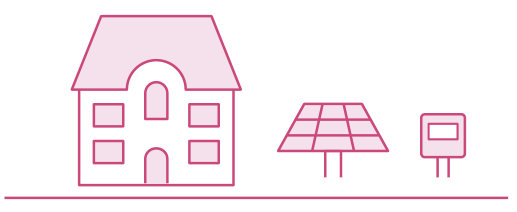
Pilot test in Walenstadt
In the Schwemmiweg district of Walenstadt, 37 households have joined forces to form a local electricity market. Twenty-eight participants have their own solar power systems, and nine are pure consumers, including a retirement/nursing home. The systems combined have an output of 290 kW and supply around 300,000 kWh of electricity annually. The electricity demand of the entire community is around 250,000 kWh per year.
Several battery systems will serve as flexible buffers for the local market, and the project partners will virtually integrate a quick-charging station for electric cars installed outside the neighborhood.
The local grid operator and electricity supplier, the Water and Electricity Works Walenstadt (WEW), is providing its distribution grid for the pilot test. The WEW levies grid costs in a bottom-up fashion: For local transactions, the grid costs are significantly lower than if the electricity were to be purchased from outside the community. Bottom-up grid tariffs differentiate between whether solar energy is traded within the community network or if energy has been supplied from outside the community network. Trading within the community involves less grid infrastructure and results in lower grid costs. However, Swiss legislation does not currently support such novel location-grid pricing schemes. Therefore, to test this novel bottom-up tariff model in the absence of regulatory support, the project team decided to cover the grid costs from higher grid levels with the project budget. WEW also participates in the local electricity market, buys surplus solar power, and supplies grid power if the Schwemmiweg district cannot generate enough of its own energy.
The local electricity market began trading on January 2019 and will continue operating for one year.
See here in real time how much solar power is produced and self-consumed within the community, as well as the extent to which the Quartierstrom community is self-sufficient.
Advantages for producers and consumers
With a local market, as much electricity as possible should be consumed locally. Consumers incur significantly lower grid costs for locally produced electricity as compared to electricity supplied from distant centralized power plants. It is therefore expected that the overall cost of electricity supplied from within the community is lower than the electricity supplied from outside the community. Together with the WEW, a bottom-up network tariff is being developed to incentivize the local exchange of energy. Selling electricity to neighbors is expected to be more lucrative for solar power producers than selling it to a utility, as the remuneration for solar electricity within the community is potentially higher than the feed-in tariff provided by the utility.
Control via an app
Participating households can use a web app to specify their individual preferences for buying and selling energy within the community: The solar power system operators determine the conditions under which they would like to market their surplus solar power to the neighborhood. And electricity consumers, on the other hand, specify the maximum price at which they would like to purchase electricity from within the neighborhood.
Beyond technology
In addition to developing the technology, the project team is also investigating the following questions:
- Are local energy markets with bottom-up grid tariffs a viable approach in the local electricity supply systems of the future? If the right framework conditions are in place, does it make economic and environmental sense for households in a community to generate a significant proportion of their electricity themselves via self-produced electricity?
- Is a blockchain suitable for processing transactions in a local electricity market? Which technologies should be used?
- How are the participants using the system? What requirements and needs do they have? What is the acceptance level for such concepts?
- Which business models make sense?
This innovative pilot project is being implemented by universities and various industry partners together with the local Walenstadt utility company, the Water and Electricity Works (WEW). The project is supported by the pilot, demonstration and lighthouse program of the Swiss Federal Office of Energy (SFOE).
White Paper on Quartierstrom
In the white paper “Quartierstrom – Implementation of a real world prosumer centric local energy market in Walenstadt, Switzerland“, the project partners from ETH Zurich and the University of St. Gallen provide an in-depth overview of the project.
 |
Sandro Schopfer, Project Manager, Bits to Energy Lab, ETH Zurich |
“The whole is greater than the sum of its parts: Communities made up of prosumers and consumers are economically and environmentally more efficient than individual households. Building such a community is an interdisciplinary task that we are implementing together with the utility of Walenstadt (WEW) for the first time.”
 |
Christian Dürr, Managing Director of the Walenstadt Water and Electricity Works |
“With the Quartierstrom Project, we intend to shorten electricity logistics and pass on part of the saved logistics costs to those who invest in photovoltaic and storage systems. This is intended to create a local market just as we know it from other industries – the only innovative feature is the blockchain element.”

The Quartierstrom project (2018-2020) was supported by the pilot, demonstration and lighthouse program of the Swiss Federal Office of Energy (SFOE).









